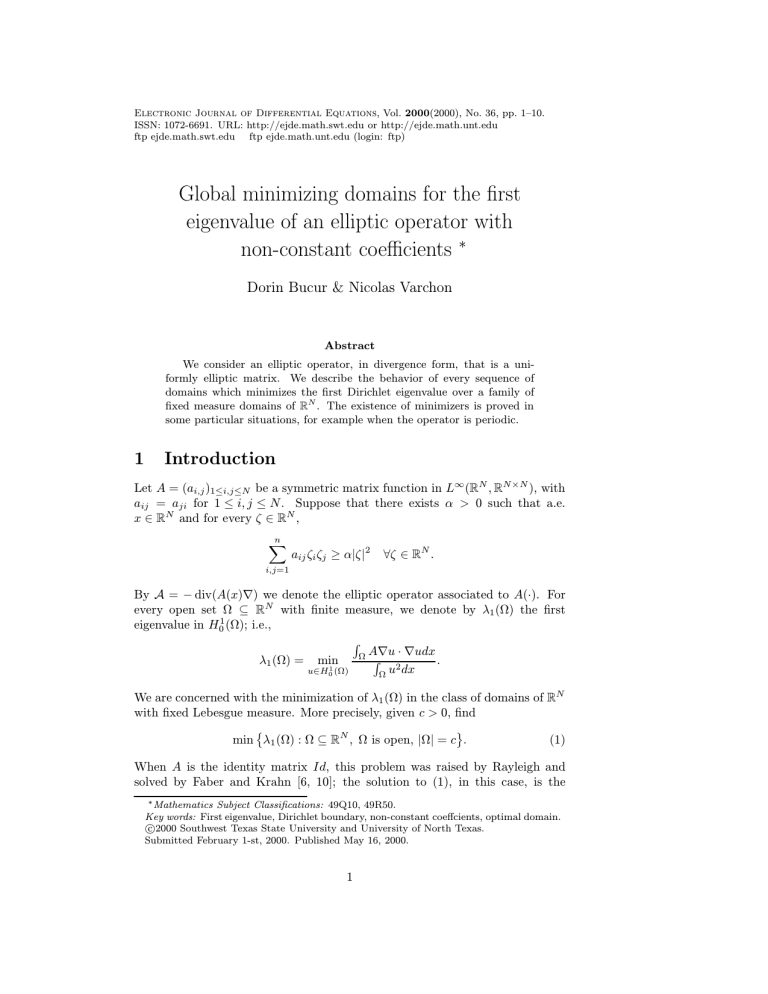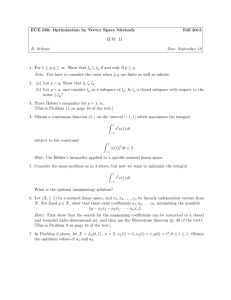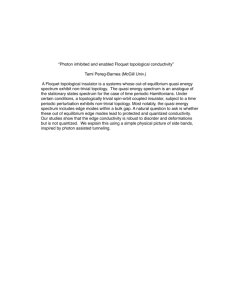Document 10749678
advertisement

Electronic Journal of Differential Equations, Vol. 2000(2000), No. 36, pp. 1–10.
ISSN: 1072-6691. URL: http://ejde.math.swt.edu or http://ejde.math.unt.edu
ftp ejde.math.swt.edu ftp ejde.math.unt.edu (login: ftp)
Global minimizing domains for the first
eigenvalue of an elliptic operator with
non-constant coefficients ∗
Dorin Bucur & Nicolas Varchon
Abstract
We consider an elliptic operator, in divergence form, that is a uniformly elliptic matrix. We describe the behavior of every sequence of
domains which minimizes the first Dirichlet eigenvalue over a family of
fixed measure domains of RN . The existence of minimizers is proved in
some particular situations, for example when the operator is periodic.
1
Introduction
Let A = (ai,j )1≤i,j≤N be a symmetric matrix function in L∞ (RN , RN ×N ), with
aij = aji for 1 ≤ i, j ≤ N. Suppose that there exists α > 0 such that a.e.
x ∈ RN and for every ζ ∈ RN ,
n
X
aij ζi ζj ≥ α|ζ|2
∀ζ ∈ RN .
i,j=1
By A = − div(A(x)∇) we denote the elliptic operator associated to A(·). For
every open set Ω ⊆ RN with finite measure, we denote by λ1 (Ω) the first
eigenvalue in H01 (Ω); i.e.,
R
A∇u · ∇udx
Ω R
.
λ1 (Ω) = min
2
1
u∈H0 (Ω)
Ω u dx
We are concerned with the minimization of λ1 (Ω) in the class of domains of RN
with fixed Lebesgue measure. More precisely, given c > 0, find
(1)
min λ1 (Ω) : Ω ⊆ RN , Ω is open, |Ω| = c .
When A is the identity matrix Id, this problem was raised by Rayleigh and
solved by Faber and Krahn [6, 10]; the solution to (1), in this case, is the
∗ Mathematics Subject Classifications: 49Q10, 49R50.
Key words: First eigenvalue, Dirichlet boundary, non-constant coeffcients, optimal domain.
c 2000 Southwest Texas State University and University of North Texas.
Submitted February 1-st, 2000. Published May 16, 2000.
1
2
Global minimizing domains
EJDE–2000/36
ball of measure equal to c. There are many proofs of this result, for example:
based on symmetrization, shape derivative techniques, moving plane method,
etc. When A has constant coefficients, by a suitable change of variables, one
can prove that a minimizer exists and is an ellipse. When A(x) = a(|x|)Id,
under some additional conditions on a(·), rearrangement techniques [1] can be
used for solving the minimization problem.
Nevertheless, when A(·) is not constant, each one of these techniques fails
because they depend strongly on the symmetry of the Laplace operator. This
is the reason for which we raise the question about the existence of a solution
to problem (1) in this paper.
If instead of looking for the minimizer in the class of all open sets of RN of
measure c, the minimizer is searched in the family of quasi open sets of fixed
measure contained in a bounded design region, the proof of existence is given by
Buttazzo and Dal Maso in [4] (see the exact definition of quasi open in [4] and in
section 2). The technique of the proof is based on relaxation and γ-convergence
arguments. However, the extension of this result in RN fails because of the lack
of compactness of the injection H 1 (RN ) ,→ L2 (RN ). An idea how to overcome
this difficulty of lack of compactness is given in [2] and in [3], but works well
only for elliptic operators with constant coefficients.
In this paper, we study the behavior of a minimizing sequence for problem (1)
when A(·) has non constant coefficients. We prove that two situations may occur: either a minimizing domain exists (and is γ-limit of a minimizing sequence)
or the minimizing sequence has a particular behavior called concentrative, i.e.,
up to some translation the sequence of the first eigenvectors converges strongly
in L2 (RN ), but the sequence of domains “goes” to infinity. In some particular
situations, as for example if the coefficients of A(·) satisfy some coerciveness like
property, or if the coefficients are periodic in space, the second situation can not
occur. As a consequence, we conclude with the existence of a minimizer.
2
Notation and preliminary results
The Lebesgue measure of a set E ⊆ RN is denoted by |E|. The capacity of a
the set E is defined by
Z
|∇u|2 + |u|2 dx, u ∈ UE
C(E) = inf
RN
where UE is the class of all functions u ∈ H 1 (RN ) such that u ≥ 1 a.e. in
a neighborhood of E. It is said that a property holds quasi everywhere on E
(shortly q.e. on E) if the set of all points x ∈ E for which the property does
not hold has capacity zero. We refer to [8, 14] for details on capacity.
A set A ⊆ RN is called quasi open if for every > 0 there exists an open
set G such that A ∪ G is open and C(G ) < . It can be easily seen that for
any quasi open set there exists a decreasing sequence {Ωn }n∈N of open sets,
containing A, such that C(Ωn \ A) → 0. Of course, any open set is also quasi
open. A quasi open set is called quasi connected, if it can not be written as
EJDE–2000/36
Dorin Bucur & Nicolas Varchon
3
the union of two quasi open sets of positive capacity having the intersection
of zero capacity. A function f : RN 7→ R is said to be quasi continuous if
for all > 0 there exists an open set G with C(G ) < such that f|RN \G is
continuous on RN \ G (see [8], [14]). Any function u ∈ H 1 (RN ) has a quasi
continuous representatives, ũ, such that ũ(x) = u(x) a.e. All quasi continuous
representative of u, are equal q.e. For a quasi open set A, the Sobolev space
H01 (A) is defined as follows:
H01 (A) = {u ∈ H 1 (RN ) : u = 0 q.e. on RN \ A}.
In this definition, the function u is supposed to be quasi continuous. If A is
open, then H01 (A) defined as above is the usual H01 -space (see [8]).
Let A be a quasi open set of finite measure. Then the injection H01 (A) ,→
2
L (A) is compact and the constant of the Poincaré inequality depends only on
the measure of A and the dimension of the space (see [13]).
The support of a function u is denoted by supp(u). The ball of RN centered
in x of radius r is denoted by B(x, r). If r = 1 we simply write B(x).
We recall the concentration-compactness principle from [5, 12].
R
Lemma 2.1 Let {un } be a bounded sequence in H 1 (RN ) such that RN u2n dx =
1. Then there exists a subsequence {unk } such that one of the following situations holds
1. Vanishing For every 0 < R < ∞
Z
lim sup
k→+∞ y∈RN
B(y,R)
u2nk dx = 0 .
2. Compactness There exists a sequence {yk } ⊆ RN such that for every
ε > 0 there exists R < +∞ for which
Z
u2nk dx ≥ 1 − ε ∀k ≥ 1 .
B(yk ,R)
3. Dichotomy There exists α ∈ (0, 1) such that for every ε > 0 there exist
two sequences {u1k } and {u2k } and k0 ≥ 1 such that for every k ≥ k0 ,
Z
|
RN
kunk − u1k − u2k kL2 (RN ) ≤ ε ,
Z
(u1k )2 dx − α| ≤ ε |
(u2k )2 dx − (1 − α)| ≤ ε ,
RN
1
dist(supp(uk ), supp(u2k ))
and
Z
lim inf
k→∞
RN
→k→+∞ +∞ ,
|∇unk |2 − |∇u1k |2 − |∇u2k |2 dx ≥ 0 .
(2)
4
Global minimizing domains
EJDE–2000/36
In (2), one can easily replace the norm of the gradient by the norm given by
the operator A, i.e. to obtain
Z
lim inf
{A∇unk · ∇unk − A∇u1k · ∇u1k − A∇u2k · ∇u2k }dx ≥ 0
(3)
k→∞
RN
We recall the following two lemmas from [9] (see also [11]).
Lemma 2.2 There exists C > 0 such that
inf
u∈H 1 (RN )\{0}
sup (2 + kuk−2
)|B(y) ∩ supp(u)| ≥ C.
L2 (RN )
y∈RN
k∇ukL2 (RN ) ≤1
Lemma 2.3 Let ε, δ and M be positive constants, and {un } be a sequence in
H 1 (RN ) such that for all n ∈ N,
k∇un kL2 (RN ) ≤ M
and
|{|un | > ε}| ≥ δ .
There exists a sequence of vectors {yn } in RN such that the sequence un (· + yn )
does not possess a weakly convergent subsequence to zero in H 1 (RN ).
3
Behavior of a minimizing sequence
This section contains our main result which describes the behavior of a minimizing sequence to problem (1). We remark that
inf{λ1 (Ω) : Ω ⊆ RN , Ω is open, |Ω| = c}
= inf{λ1 (Ω) : Ω ⊆ RN , Ω is quasi open, |Ω| ≤ c}.
For this reason we set the problem
min{λ1 (Ω) : Ω ⊆ RN , Ω
is quasi open, |Ω| ≤ c}.
(4)
Observe that is possible that problem (4) has a solution, while problem (1) does
not. Nevertheless, we are not able to give an example of matrix A(·) such that
the optimum is quasi open, and not open.
Suppose that {Ωn } is a minimizing sequence of open sets for problem (4).
By un we denote a first eigenvector of A on Ωn , such that |un |L2 (RN ) = 1. As
Ωn is minimizing, it is easy to see that λ1 (Ωn ) is simple from rank on, and
that Ωn can be replaced by the open connected set {un 6= 0}, in the sense that
the sequence {un 6= 0} is also minimizing for the same problem. For connected
open sets Ωn , we therefore denote by un the unique positive normalized first
eigenvector.
In order to describe the behavior of a minimizing sequence for problem (4),
we define what is a concentrative sequence.
EJDE–2000/36
Dorin Bucur & Nicolas Varchon
5
Definition 3.1 A sequence of connected open sets {Ωn } is called A-concentrative,
if there exists a sequence of vectors {yn } ∈ RN such that un (·+ yn ) strongly converges in L2 (RN ).
The following theorem contains the main result of the paper.
Theorem 3.2 One of the two following situations occurs:
1. There exists a quasi open, quasi connected set A solution of problem (4).
2. For any minimizing sequence of open sets {Ωn } for problem (4), there exists
{nk } and a concentrative sequence of open connected sets Ω̃k ⊆ Ωnk which is
also minimizing, such that inf x∈Ω̃k |x| → ∞ when k → ∞.
Proof Let us suppose that the first situation does not occur. Then, we consider a minimizing sequence of open sets for problem (4), say {Ωn }. We denote
by {un } the sequence of positive, normalized first eigenvectors on Ωn . It is obvious that this sequence is bounded in H 1 (RN ) since {Ωn } is minimizing and
A(·) is uniformly elliptic. Therefore, the concentration-compactness lemma can
be applied for the sequence {un }. We treat separately each situation.
Vanishing Let us suppose that up to a change of the indices and extraction of
a subsequence, for every R > 0 we have
Z
lim sup
u2n dx = 0.
k→+∞ y∈RN
B(y,R)
In the sequel, we prove that this situation can not occur, since this would imply
that λ1 (Ωn ) → ∞.
Lemma 3.3 Let {un } a bounded sequence in H 1 (RN ) such that kun kL2 (RN ) = 1
and un ∈ H01 (Ωn ) with |Ωn | ≤ c. There exists a sequence of vectors {yn } ⊂ RN
such that the sequence {un (.+yn )} does not possess a weakly convergent sequence
in H 1 (RN ).
Proof Assume that kun kH 1 (RN ) ≤ M . For every ε > 0, we have
Z
Z
Z
u2n dx ≤
ε2 +
((un − ε)+ + ε)2 dx .
1=
Ωn
{un ≤ε}∩Ωn
{un >ε}
Using the Cauchy-Schwarz inequality, a simple computation leads to
√
1 ≤ ( cε + k(un − ε)+ kL2 (RN ) )2 .
√
Taking ε0 = 1/(2 c), we obtain
1 ≥ k(un − ε0 )+ kL2 (RN ) ≥
1
.
2
(5)
Since k∇(un − ε0 )+ kL2 (RN ) ≤ M , we can apply lemma 2.2. Therefore, there
exists a constant C > 0, a sequence {yn } of RN such that for every n ∈ N
+
(2 + M 2 k(un − ε0 )+ k−2
L2 (RN ) ) |B(yn ) ∩ supp(un − ε0 ) | ≥ C .
6
Global minimizing domains
EJDE–2000/36
Using (5) and |{un > ε0 }| ≥ |B(yn ) ∩ supp(un − ε0 )+ |, we get
|{un > ε0 }| ≥
C
.
4M 2 + 2
Applying lemma 2.3, the conclusion follows.
♦
We prove now that if the vanishing occurs for the sequence {un }, then we get
lim supn→∞ λ1 (Ωn ) = ∞, which will contradict the choice of {Ωn } as minimizing
sequence of the first eigenvalues. Indeed, suppose that lim supn→∞ λ1 (Ωn ) < ∞.
The sequence {un } is therefore bounded in H 1 (RN ), hence lemma 3.3 applies.
One can therefore subtract a subsequence (still denoted with the same index)
and a sequence of vectors yn ∈ RN such that un (· + yn ) weakly converges to a
non zero element in H 1 (RN ). This contradicts the vanishing of {un }.
Compactness Let us suppose that when applying the concentration-compactness
lemma for {un }, the compactness situation holds. For a subsequence (still denoted with the same index) and for a sequence of vectors {yn } ∈ RN we have
L2 (RN )
un (· + yn ) −→ u .
Two situations may occur: either {yn } has a bounded subsequence, or |yn |RN →
∞. In the first case, up to subtraction of a subsequence and a renotation of the
indices, we can suppose that yn → y. It is easy to see that
L2 (RN )
un −→ u(· − y) .
In the second case
Z
Z
A∇un · ∇un dx ≥
lim inf
n→∞
Ωn
RN
A∇u(x − y) · ∇u(x − y) dx .
Taking a quasi continuous representative for u, we set Ω = {u(· − y) > 0}. Then
Ω is a solution for problem (4).
Assuming that |yn |RN → ∞ we get that the sequence {Ωn } is concentrative.
Indeed, one can construct two sequences {u1k } ⊆ H 1 (RN ) and {Rk } ⊆ RN such
that
Z
|unk − u1k |2 dx → 0,
Rk → +∞
Z
lim inf [
k→∞
RN
supp u1k ⊆
Ωnk
A∇unk
supp unk ∩ Bynk ,Rk ,
Z
· ∇unk dx −
Ωnk ∩Byn
|ynk |RN ≥ 2Rk ,
A∇u1k · ∇u1k dx] ≥ 0 .
k
,Rk
The construction of {u1k } ⊆ H 1 (RN ) and R{Rk } ⊆ RN can be done using the
concentration function Qn (R) = supy∈RN By,R u2nk dx. For every ε > 0, there
exists Rε and nε such that for every R ≥ Rε and n ≥ nε we have Qn (R) ≥ 1 − ε
(see [12]). We consider a function ξ ∈ C0∞ (RN ) with 0 ≤ ξ ≤ 1, ξ = 1 on B(0, 1)
x
ξ = 0 on RN \ B(0, 2). We define φ = 1 − ξ, and φR (x) = φ( R
).
EJDE–2000/36
Dorin Bucur & Nicolas Varchon
7
We chose nk such that |ynk | ≥ 4Rε and define u1k = unk φRε . For a sequence
ε → 0 we chose Rk = 2Rε , and like in [12] it can be proved that all requirements
are satisfied.
As a consequence we have that Ω̃k = Ωnk ∩ Bynk ,Rk is also a minimizing
sequence, but concentrative. Moreover inf x∈Ω̃k |x| → +∞.
Dichotomy Let us suppose that the sequence {un } is in the dichotomy situation. There exists α > 0 such that by a diagonal subtraction procedure, one can
extract a subsequence (still denoted with the same index) and construct two sequences {u1n } and {u2n } with disjoint support such that kun −(u1n +u2n )kL2 (RN ) →
0, ku1n kL2 (RN ) → α > 0, ku2n kL2 (RN ) → 1 − α > 0 and
Z
[A∇un · ∇un − A∇u1n · ∇u1n − A∇u2n · ∇u2n ]dx ≥ 0 .
lim inf
n→∞
Ωn
The construction of these two sequences follows the same ideas as for compactness (see [12]). In this case, the concentration functions are upper bounded by
α, and for suitables Rn we have that u1n = un ξRn u2n = un φkn Rn , with kn → ∞.
It is immediate that the sequences of quasi open sets {u1n > 0} and {u2n > 0}
are also minimizing for problem (4) (these sets are defined for quasi continuous
representatives of u1n and u2n ). It is obvious that |{u1n > 0}| + |{u2n > 0}| ≤ c.
For each n ∈ N, at least one of the sets {u1n > 0}, {u2n > 0} has the Lebesgue
measure, less than or equal to 2c . Renoting this sequence {Ω1n } we obtain in such
a way a minimizing sequence for problem (4), such that |Ω1n | ≤ 2c . For this minimizing sequence we start again the algorithm, i.e. we apply the concentrationcompactness lemma to the sequence of normalized first eigenvectors. If this
sequence vanishes or leads to compactness, the answer of theorem 3.2 follows.
If not, using the previous procedure given by the dichotomy, we construct a
minimizing sequence {Ω2n } with |Ω2n | ≤ 4c .
Continuing this procedure, two possibilities occur: either we stop at some
moment since vanishing or compactness occurs, or by a diagonal procedure we
can subtract a minimizing sequence {Ωknn } with the property that |Ωknn | →
0 for n → ∞. This last situation is in fact impossible, since if |Ωknn | → 0,
then λ1 (Ωknn ) → ∞. The proof of this assertion is an easy consequence of the
ellipticity condition of A and the Poincaré inequality.
♥
If instead of a general non constant operator A we would have an elliptic
operator in divergence form with constant coefficients, the dichotomy could
have been solved directly since any minimizing sequence of sets must have the
measure converging to c. This assertion comes by an homothethy argument,
which is not anymore valid for operators with non constant coefficients.
If problem (4) has a solution, then this solution has the Lebesgue measure
of the optimal set is equal to c. Indeed, if Ω is a solution such that |Ω| < c, then
there exits a connected open set containing strictly Ω with measure equal to c,
denoted Ω∗ . From the optimality of Ω, we get that the first eigenvector on Ω is
also first eigenvector on Ω∗ , but this contradicts the strong maximum principle,
since the first eigenvector on an open connected set can not vanish on a set of
positive measure.
8
Global minimizing domains
EJDE–2000/36
If problem (4) has a solution, then this solution is quasi connected. Indeed,
if Ω is solution, and Ω = Ω1 ∪ Ω2 , such that Ω1 , Ω2 are nonempty quasi open
with C(Ω1 ∩ Ω2 ) = 0, we immediately have that Ω1 and Ω2 are also minimizers.
This is not possible, since |Ω1 | < c and contradicts the previous assertion.
4
Further remarks and applications
In this section we give some applications to Theorem 3.2 and formulate some
open questions. Assume that A is a periodic matrix in RN ; i.e., suppose the
existence of l ∈ RN such that for all k1 , . . . , kN ∈ NN we have
A(x) = A(x1 + k1 l1 , . . . , xN + kN lN ).
Proposition 4.1 Under the previous hypotheses on A, problem (4) has at least
one solution.
Proof We apply Theorem 3.2. If we are in the first situation, problem (4) has
at least a solution. In the sequel, we prove that the second situation also leads to
the existence of a solution. Suppose that {Ωn } is a minimizing sequence, which
is concentrative. There exists {yn } such that un (· − yn ) strongly converges to
u in L2 (RN ). There exits ln = (kn1 l1 , . . . , knN lN ) with kn1 , .., knN ∈ N such that
|yn − ln |RN ≤ |l|RN .
The sequence vn := un (· − ln ) has a subsequence strongly convergent in
L2 (RN ). Indeed, for a subsequence still denoted with the same index, we have
yn − ln → x ∈ RN . Then, we get un (· − ln ) strongly converges to u(· + x) in
L2 (RN ).
From the periodicity of A, we have that Ωn − ln is also minimizing, hence by
the same construction as in theorem 3.2 we get that {u(· + x) > 0} is a solution
for problem (4).
♦
Example For the operator A(x) = (1 + exp(−|x|))Id, there is no solution to
problem (4). Let
λc = inf{λ1 (Ω) : Ω is quasi open,
|Ω| ≤ c}
be the first eigenvalue of the Laplace operator on a ball of measure equal to c.
This infimum is obtained by a ball (of measure c ) “going” to infinity. However,
the infimum is not attained.
Given a general operator with non constant coefficients, it is difficult to
establish whether problem (4) has a solution or not. If by any mean, one can
prove a “coerciveness” result asserting that the minimum should be searched
in a bounded region of RN , then the results of [4] would immediately give the
positive answer. Nevertheless, this type of result is, in general, very difficult
to obtain. The minimizer itself might be unbounded. It would be interesting
to find an example of a matrix function A(·) for which problem (4) has an
unbounded solution.
EJDE–2000/36
Dorin Bucur & Nicolas Varchon
9
In some particular cases, as for example if the matrix A satisfies some coerciveness hypotheses which forbids to the minimizing sequence of domains to be
concentrative, then the existence of a solution for problem (4) can still be proved.
Let us denote by c(x) the ellipticity coefficient of the matrix A(x). If there exist
a quasi open set Ω of measure c such that λ1 (Ω) ≤ λc lim inf |x|→+∞ c(x) then it
is easy to see that the second situation of theorem 3.2 can not occur.
If the same problem is raised for another eigenvalue, or for a function of
eigenvalues, it seems to be rather difficult to describe precisely the behavior of a
minimizing sequence. The main reason is because one should relay on a general
concentration-compactness like result for the resolvent operators associated to
A(·). An extension of the general result of [4] in RN would be of great interest.
Open questions
1. If A has periodic coefficients, is the minimizer domain bounded?
2. If A has periodic and smooth coefficients, is the minimizer domain smooth?
For the second question, we refer the reader to [7], where a penalty technique is
used to prove openness of some optimal domains in a class of shape optimization
problem.
Another interesting question is to decide whether the dichotomy might occur
or not when solving problem (4) for a general operator. If this would be the
case, then
inf{λ1 (Ω) : |Ω| ≤ c} = inf{λ1 (Ω) : |Ω| ≤ c − ε}.
for some ε > 0. We do not have an example of elliptic operator for which this
equality occurs.
References
[1] Betta, F., Brock, F., Mercaldo, A., Posterano, M. A weighted isoperimetric inequality and applications to symetrizations , Journal of Inequalities and
Applications (to appear), (2000).
[2] Bucur, D. Uniform concentration compactness of a sequence of Sobolev spaces,
J. of Diff. Equations 162 (2) (2000), 427-450.
[3] Bucur, D.; Henrot, A. Minimization of the third eigenvalue of the Dirichlet
Laplacian, Proc. Roy. Soc. London, Ser. A, 456 (2000), p. 985-996.
[4] Buttazzo, G.; Dal Maso, G. An existence result for a class of shape optimization problems, Arch. Rat. Mech. Anal., 122 (1993), 183-195.
[5] Esteban M.J.; Lions, P.L. Γ-convergence and the concentration-compactness
method for some variational problems with lack of compactness. Ricerche di
Matematica, XXXVI, fasc. 1 (1987), 73–101.
[6] Faber, G. Beweis, dass unter allen homogenen Membranen von gleicher Fläche
und gleicher Spannung die kreisförmige den tiefsten Grundton gibt , Sitz. Ber.
Bayer. Akad. Wiss. (1923), 169-172.
10
Global minimizing domains
EJDE–2000/36
[7] Hayouni, M. [1999]: Lipschitz continuity of the state function in a shape optimization problem, Journal of Convex Analysis, 6, 71-90.
[8] Heinonen, J.; Kilpelainen, T.; Martio, O. Nonlinear potential theory of
degenerate elliptic equations, Clarendon Press, Oxford, New York, Tokyo, 1993.
[9] Kavian, O. Introduction à la théorie des points critiques et applications aux
problèmes elliptiques. Mathématiques et applications, 13, Springer-Verlag, (1993).
[10] Krahn, E. Über eine von Rayleigh formulierte Minimaleigenschaft des Kreises,
Math. Ann., 94, (1924), 97-100.
[11] Lieb, E.H. On the lowest eigenvalue of the Laplacian for the intersection of two
domains. Inventiones matematicae, 74, (1983), 441–448.
[12] Lions, P.L. The concentration-compactness principle in the Calculus of Variations. The locally compact case, part 1. Ann. Inst. Poincaré, 1, no. 2 (1984),
109–145.
[13] Willem, M. Analyse harmonique réele, Hermann, Paris, (1995).
[14] Ziemer, W. Weakly differentiable functions, Springer-Verlag, Berlin, (1989).
Dorin Bucur
Equipe de Mathématiques, UMR CNRS 6623
Université de Franche-Comté
16, route de Gray, 25030 Besançon Cedex, France
email: bucur@math.univ-fcomte.fr
Nicolas Varchon
Equipe de Mathématiques, UMR CNRS 6623
Université de Franche-Comté
16, route de Gray, 25030 Besançon Cedex, France
email: varchon@math.univ-fcomte.fr








